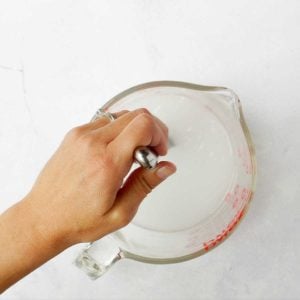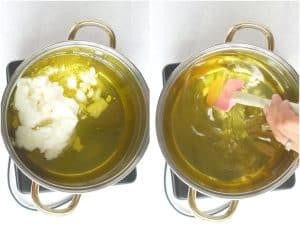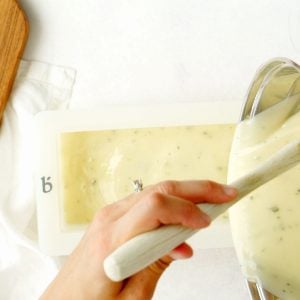How to Make Pretty Homemade Basil Soap for Summer
Here’s a recipe for cold-process basil soap: it’s affordable and uses dried basil and basil essential oil.
This is one of my favorite cold-process soap recipes to keep by the kitchen sink. You can make it any time of year, but I use it most in summer because I love the freshness of the fragrance.
Summer Basil Cold Process Soap Recipe

Equipment
Ingredients
- 4.28 ounces lye
- 10 ounces water
- 12 ounces olive oil
- 11 ounces coconut oil
- 3 ounces avocado oil
- 2 ounces shea butter
- 2 ounces castor oil
- 2 teaspoons dried basil
- 1 teaspoon basil essential oil
Save This Recipe
You'll join my email list which you will love. And if you don't, unsubscribe in one click. ❤️
Instructions
- Make lye water. Measure out the lye and the water in separate, non-reactive containers, using a digital scale. Mix the lye and the water and stir until dissolved, adding the lye to the water, never the other way around. The lye solution will heat up as a result of a chemical reaction. Be careful of fumes, heat, and the corrosive solution. Set the cup aside to cool in a very safe place.

- Measure oils. Measure out the oils in separate containers and place them in a pot. Melt over medium-low heat until fully melted and about degrees. The shea butter will take longer to melt, but keep the oils over the heat until it is fully melted. Remove from the heat and set aside to cool.

- Check the temperature of the oils and water. When they have cooled to 90-110 degrees, you are ready to blend. Before blending, have your soap mold, basil oil, and dried basil ready to go.
- Blend to trace. Pour the lye solution into the melted oils and blend with a stick blender until you reach a trace. Trace is reached when the soap forms a batter and the stick blender leaves a trail when dragged across the top of the pot. Once the trace is reached, add the basil oil and dried basil. Stir in by hand. I

- Pour into mold. Immediately pour the soap batter into the mold. Place on the counter or other safe, room temperature place to cure for 24 hours.

- Turn out the loaf of soap and slice it into bars. Allow to bars to cure in a well-ventilated space for at least 2 weeks before using. This soap has a high percentage of olive oil, so it may seem soft at first. It will firm up within the first two days, but allow to cure for at least 3 weeks for the best results.
Video
Notes

Sourcing Your Materials
- Basil Essential Oil: There’s no point paying for a pricey essential oil; the heat of the curing process will change it. I use this affordable oil.
- For lye and base oils such as coconut, castor, etc., Nurture Soap has the best prices and a great selection of colors and fragrance oils.
- Amazon is a great choice for tools like molds, a stick blender, and soap-making safety gear.
- You can find all my recommendations for soap-making supplies here.
Customizing Your Basil Soap Recipe
If you’d like to resize it, you’ll need to enter percentages into a lye calculator. It will put out the amounts of oil and lye you’ll need to use. This is my favorite lye calculator.
The basil oil can be left out or substituted for another fragrance oil or essential oil. Each oil has its own usage guidelines that you’ll need to refer to in order to see how much you need. Keep in mind that the basil oil has a very strong fragrance on its own and it is likely to overpower anything else you add to it.
Adding a light green color would be beautiful.
Diving Deeper Into Cold-Process Soap
Never made homemade soap before? Don’t be intimidated! But do read my beginner’s guide to homemade soap before you dive in.
Want to try other herbs? Go right ahead. Any dried herb will work well, especially thyme or mint. You can dry your own herbs, or just buy them from the spice aisle of the grocery store. No need to overthink this.
If you want to add fresh herbs, you’ll want to puree them as you blend the soap batter. Bigger pieces of fresh herbs will shorten the shelf life of your soap.
The lemon zest in soap is a great choice as well. This recipe adds it in two places for a pretty, fresh-looking bar.
FAQs
Yes, but puree the fresh basil well to avoid large pieces that can affect the soap’s shelf life.
Use a digital scale and always add lye to water, never the other way around. Ensure you’re working in a well-ventilated area and wear protective gear.
Adding ingredients like cocoa butter or using a higher percentage of olive oil can help create a nice hard bar of soap.
Substitutions and Variations
- Using Different Oils: You can substitute olive oil with canola oil or sunflower oil. Both oils are rich in essential fatty acids and work well in soap recipes.
- Adding Natural Colorants: Incorporate natural colorants like French green clay or tomato pure for a unique touch.
- Using Ice Cube Trays: For fun, small batches of soap, pour the soap batter into ice cube trays instead of a regular mold.
I hope you give this easy basil soap recipe a try. It’s perfect for hands and you’ll love its subtle fragrance and gentle cleansing power.
Love,







Could I use goats milk instead of water?
yes that will work fine.
Another great recipe. Thanks.
Just signed on today & love the soap recipie but, in Florida the castor oil leaves large brown dots in soap even when cured for 2 whole months, can I sub. Or leave it out? Have been making c.p. soap for many years. I am waiting for a small steal barn shed to come to the property soon, this will be my new temp. regulated soap making room, can’t wait 🤗!
Hey Cheryl, castor oil is the BEST for lots of lather and there’s no great substitute that will be quite like it. for this particular recipe i’d do one. more ouncce avocado oil and one more olive. run it through a lye calculator first 🙂
Why not the normal 4-6 weeks? Are you using less water? The soap is beautiful, I can’t wait to try it. Thank you for sharing!!
Yes this has less water but 4-6 weeks is always a better option if you have the patience 😊
Hello Katie!
I have a family member with avocado allergies. What can I use instead of avocado oil?
Oh and first time soap maker here!!!
Thank you!
His
Shari
hi shari! Almond oil is usually a good substitute for avocado!
Hi
I am a first time soap maker and I am going to use your recipe it looks easy to follow and I watched your video on YouTube. My question is how much soap does this recipe yield? I am trying to figure out so I am able to buy appropriate amount of stuff example coconut oil Costco 1l what that will yield per recipe. Does this make sense? Thanks in advance!
hi nora, the “loaf” I use is 10 inches long and makes about 8 good sized bars of soap. Hope that’s helpful 🙂
What a perfect recipe! Love to try this basil soap and would love to add natural additions and some twists! 😍